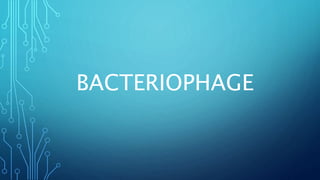bacteriophage.pptx
•Télécharger en tant que PPTX, PDF•
0 j'aime•11 vues
Bacteriophage, or phages, are viruses that infect and replicate within bacteria. They have a protein coat that encapsulates either DNA or RNA and a tadpole shape with a hexagonal head and cylindrical tail. Phages have two life cycles: the lytic cycle kills the host bacterium to release new phages, while the lysogenic cycle incorporates the phage genome into the host genome without killing the cell. Phage therapy uses bacteriophages to treat bacterial infections and has advantages over antibiotics like host specificity and reduced risk of resistance development.
Signaler
Partager
Signaler
Partager

Recommandé
Recommandé
Contenu connexe
Similaire à bacteriophage.pptx
Similaire à bacteriophage.pptx (20)
An Overview of Immunity to Viruses, Bacteria, Fungi and Ptozoans

An Overview of Immunity to Viruses, Bacteria, Fungi and Ptozoans
Microbial Pathogens in Non-Clinical Environments (NCE)

Microbial Pathogens in Non-Clinical Environments (NCE)
Plus de anjalisaini751329
Plus de anjalisaini751329 (7)
Dernier
Dernier (20)
300003-World Science Day For Peace And Development.pptx

300003-World Science Day For Peace And Development.pptx
POGONATUM : morphology, anatomy, reproduction etc.

POGONATUM : morphology, anatomy, reproduction etc.
Cyathodium bryophyte: morphology, anatomy, reproduction etc.

Cyathodium bryophyte: morphology, anatomy, reproduction etc.
GBSN - Biochemistry (Unit 2) Basic concept of organic chemistry 

GBSN - Biochemistry (Unit 2) Basic concept of organic chemistry
LUNULARIA -features, morphology, anatomy ,reproduction etc.

LUNULARIA -features, morphology, anatomy ,reproduction etc.
Climate Change Impacts on Terrestrial and Aquatic Ecosystems.pptx

Climate Change Impacts on Terrestrial and Aquatic Ecosystems.pptx
Human & Veterinary Respiratory Physilogy_DR.E.Muralinath_Associate Professor....

Human & Veterinary Respiratory Physilogy_DR.E.Muralinath_Associate Professor....
Gwalior ❤CALL GIRL 84099*07087 ❤CALL GIRLS IN Gwalior ESCORT SERVICE❤CALL GIRL

Gwalior ❤CALL GIRL 84099*07087 ❤CALL GIRLS IN Gwalior ESCORT SERVICE❤CALL GIRL
Use of mutants in understanding seedling development.pptx

Use of mutants in understanding seedling development.pptx
PATNA CALL GIRLS 8617370543 LOW PRICE ESCORT SERVICE

PATNA CALL GIRLS 8617370543 LOW PRICE ESCORT SERVICE
Thyroid Physiology_Dr.E. Muralinath_ Associate Professor

Thyroid Physiology_Dr.E. Muralinath_ Associate Professor
FAIRSpectra - Enabling the FAIRification of Analytical Science

FAIRSpectra - Enabling the FAIRification of Analytical Science
bacteriophage.pptx
- 2. INTRODUCTION Bacteriophage (bacteria-eater), as the name suggests, are the viruses that infect and replicate within bacteria. They are commonly called a phage. They are found everywhere. They contain DNA or RNA in their genome, which is encapsulated in a protein coat. They also infect archaea. Bactericidal activity of bacteriophage was first observed in 1896 by Ernest Hanbury Hankin in the water of river Ganges, which could kill cholera bacteria.William Twort discovered bacteriophage in 1915. D’Hérelle termed them as ‘bacteriophage’ in 1917, as they showed the ability to kill bacteria. There are several types of phage virus, which infect only certain bacteria specifically. They act in the same way as antibiotics by disrupting the cell wall of
- 3. STRUCTURE AND MORPHOLOGY • Tadpole shaped • Hexagonal head • cylindrical tail • Head: nucleic acid (dsDNA) surrounded by protein coat or capsid; 28-100 nm size • Tail: hollow core, surrounded by contractile sheath and terminal base plate 5
- 4. LIFE CYCLE OF BACTERIOPHAGE THE LYTIC CYCLE INVOLVES THE REPRODUCTION OF VIRUSES USING A HOST CELL TO MANUFACTURE MORE VIRUSES; THE VIRUSES THEN BURST OUT OF THE CELL. THE LYSOGENIC CYCLE INVOLVES THE INCORPORATION OF THE VIRAL GENOME INTO THE HOST CELL GENOME, INFECTING IT FROM WITHIN LYTIC CYCLE:
- 6. PHAGE THERAPY • Phage therapy, viral phage therapy, or phagotherapy is the therapeutic use of bacteriophages for the treatment of pathogenic bacterial infections. • Advantages include reduced side effects and reduced risk of the bacterium developing resistance • Bacteriophages are much more specific than antibiotics. They are typically harmless not only to the host organism but also to other beneficial bacteria, such as the gut microbiota, reducing the chances of opportunistic infections. • Phages tend to be more successful than antibiotics where there is a biofilm covered by a polysaccharide layer, which antibiotics typically cannot penetrate. • Phage therapy has many potential applications in human medicine as well as dentistry, veterinary science, and agriculture. If the target host of a phage therapy treatment is not an animal, the term “biocontrol” (as in phage- mediated biocontrol of bacteria) is usually employed, rather than “phage